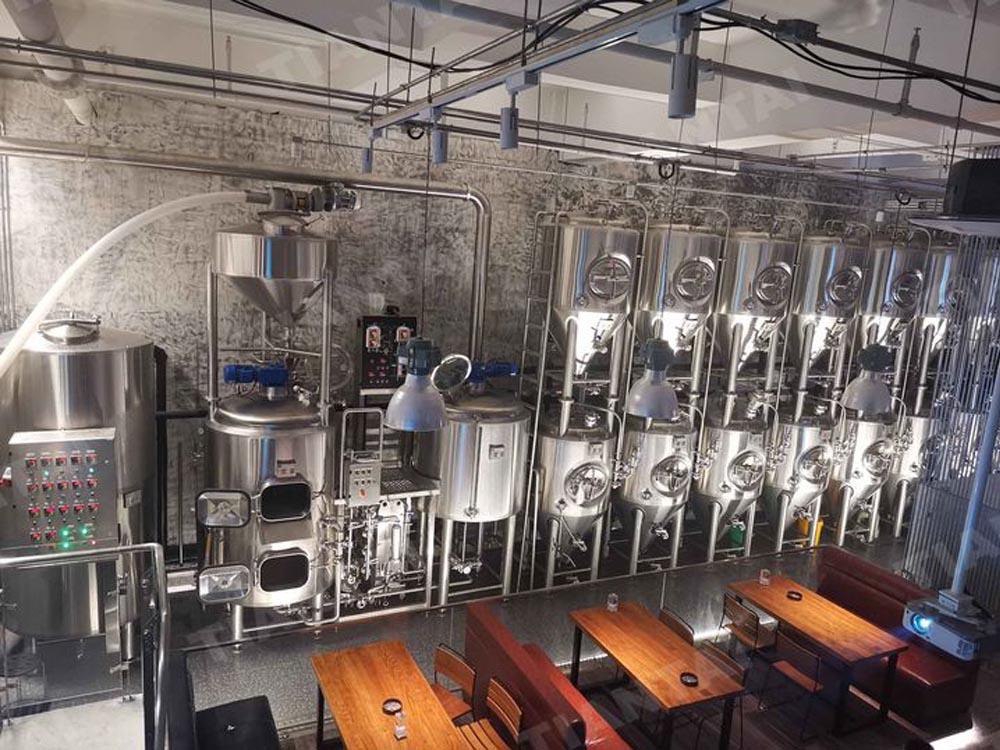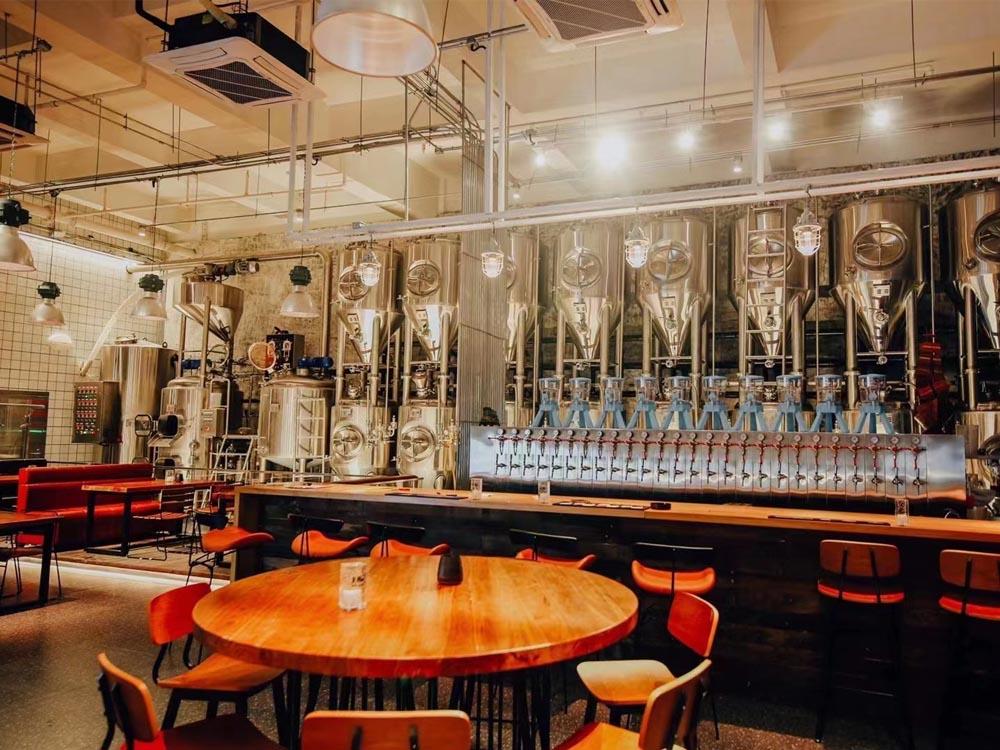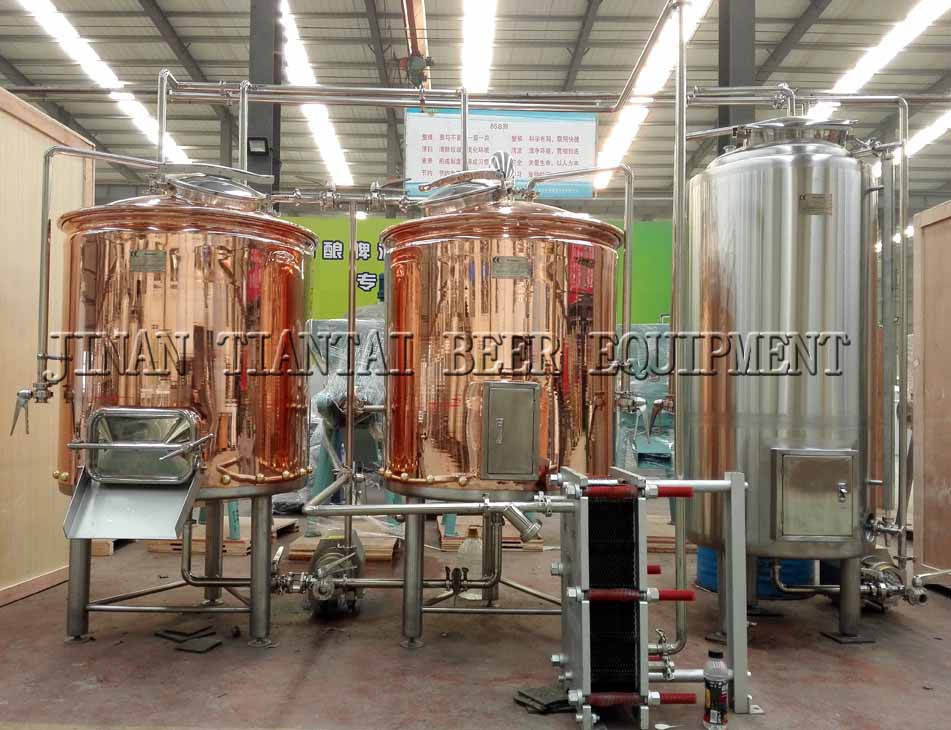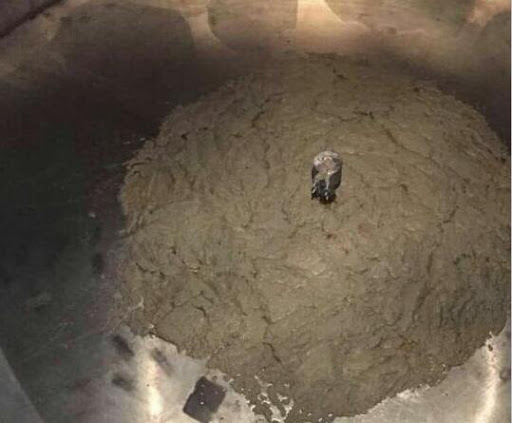How to plan the electricity consumption of the brewery during the establishment of the brewery
- Nov 02, 2024
- 120
- tiantai
Setting up a brewery needs considering much aspect. Electricity is a big points that we should plan in advance.
Part 1: How to plan the brewery electricity consumption during setting up brewery
Planning electricity consumption for a brewery is essential to ensure efficient operations, avoid power shortages, and minimize costs.
Here’s a detailed approach to help you estimate and plan electricity needs effectively:
1. Assess Equipment Power Requirements
List all the major and minor equipment and their respective power ratings. The main energy-consuming equipment in a brewery typically includes:
Brewhouse System: Heating elements, pumps, and stirring motors.
Fermentation and Storage Tanks: Cooling systems for glycol chillers.
Bottling and Packaging Equipment: Motors and compressors.
Cleaning Systems (CIP): Pumps and heaters.
Air Compressors and CO2 Systems: For carbonation and general use.
Auxiliary Equipment: Lighting, computers, and ventilation.
2. Calculate Individual Power Consumption
For each piece of equipment, use the formula:
Power Consumption (kWh)=Power Rating (kW)×Operating Hours
For example, if a 10 kW pump runs for 4 hours a day:
10 kW×4 hours=40 kWh/day
3. Estimate Daily and Monthly Consumption
Sum up the daily power consumption of all equipment.
Multiply by the number of days your brewery operates in a month to estimate the total monthly consumption.
4. Consider Peak Load Management
Peak Power Demand: Identify periods of high electricity usage. In brewing, peak demand often occurs during heating, boiling, and cooling phases.
Demand Charge Reduction: Implement strategies like staggering operations, using energy storage systems, or scheduling high-demand activities during off-peak hours.
5. Plan for Energy Efficiency
Use Energy-Efficient Equipment: Invest in energy-efficient motors, LED lighting, and insulation for tanks and piping.
Heat Recovery Systems: Recover heat from wort cooling or steam to use in pre-heating water.
Variable Frequency Drives (VFDs): Install VFDs on pumps and compressors to optimize energy use based on demand.

6. Install a Monitoring System
A real-time monitoring system can help track energy usage and identify areas where power consumption can be reduced.
Consider software that provides data analytics for optimizing energy efficiency.
7. Factor in Future Expansion
If you plan to scale up production or add new equipment, account for additional power requirements in your initial setup. This might involve installing a higher-capacity electrical panel or wiring system to accommodate future needs.
8. Work with an Electrical Engineer
Consult with a professional to design an electrical system that meets your brewery’s needs safely and efficiently. They can help you choose the appropriate:
Transformer capacity
Distribution panels
Backup power solutions (like generators, if necessary)
Example of Electricity Breakdown
For a medium-sized brewery producing around 20-30 HL per batch:
Brewhouse (Heating & Pumping): ~50-80 kWh per batch
Fermentation (Cooling & Control Systems): ~10-20 kWh per day per tank
Glycol Chiller: ~30-60 kWh per day, depending on the cooling load
Packaging Line: ~20-40 kWh per operating hour
Tips for Reducing Electricity Costs
Schedule operations during off-peak electricity hours if your utility provider has variable rates.
Use renewable energy sources, like solar panels, to offset some power consumption.
Regular maintenance of equipment ensures efficiency and reduces unexpected energy spikes.
Proper planning and energy management not only reduce operating costs but also support sustainability goals. Let me know if you need specific details for your brewery size or equipment!

Part 2: Anything we need note when planing the brewery electricity consumption?
Yes, there are several important considerations to pay attention to when planning the electricity consumption for your brewery:
1. Power Supply Stability
Ensure that your location has a stable and reliable power supply to prevent unexpected interruptions, which can be damaging, especially during critical brewing phases like boiling or fermentation.
Consider having a backup power source, such as a generator or an uninterruptible power supply (UPS), for essential equipment.
2. Electrical Safety
Wiring and Grounding: Proper electrical wiring and grounding are essential to prevent accidents or equipment malfunctions. Work with certified electricians to meet safety standards.
Water-Proofing: Since breweries involve significant amounts of water and steam, make sure all electrical components are adequately waterproofed and protected from moisture.
3. Load Management
Avoid Overloading: Ensure that your brewery’s electrical system can handle the maximum load, especially during peak operation times. Overloading circuits can lead to power outages or equipment damage.
Phased Equipment Use: Stagger the operation of high-power equipment to distribute the load evenly throughout the day.
4. Energy Efficiency
Regularly maintain and clean motors, chillers, and heating elements to ensure they operate efficiently.
Insulate steam lines and tanks to minimize energy loss and reduce heating costs.
5. Temperature Control Systems
Glycol chillers and fermentation temperature controls consume significant energy. Ensure that your cooling systems are appropriately sized for your brewing capacity and are operating efficiently.
Monitor for Leaks: Glycol or refrigerant leaks can increase energy consumption, so regular inspections are crucial.
6. Compliance with Local Regulations
Be aware of and comply with local electrical codes and safety regulations. This may involve obtaining permits and having regular inspections.
If your brewery is in a residential or commercial area, check for noise level restrictions associated with generators or cooling systems.
7. Renewable Energy Considerations
If you plan to integrate renewable energy sources like solar panels, ensure that your electrical setup can handle both grid and off-grid power seamlessly.
Consider energy storage options (like batteries) to make the most of renewable energy and reduce dependency on the grid during peak hours.
8. Future-Proofing
Design your electrical system with the future in mind, allowing for easy expansion. This includes installing extra capacity in panels and running additional conduit for future equipment.
Consider investing in smart energy management systems that can help you track consumption and optimize energy use over time.
By addressing these considerations, you can ensure your brewery operates efficiently and safely while keeping energy costs under control. Let me know if you have specific challenges or need guidance on particular aspects of your brewery setup!

Part 3: When planning a brewery, when should electrical planning be done?
Electricity planning for a brewery should be conducted early in the planning and design phase of your brewery project. Here’s why timing is crucial and what you should consider:
1. During the Initial Design Phase
Space Planning: The layout of your brewery, including the placement of the brewhouse, fermenters, and packaging lines, will influence the electrical design. Electrical systems must be integrated into the overall architectural and engineering plans.
Power Requirements Assessment: Understanding the energy demands of your brewing equipment and building infrastructure helps determine the size and capacity of your electrical setup.
2. Before Equipment Installation
Electrical planning must be complete before you install any brewing equipment. This ensures that the right outlets, circuits, and power supplies are available and can support the equipment safely and efficiently.
Electrical Infrastructure Preparation: Proper wiring, circuit breakers, and panels must be installed and tested before bringing in brewing systems.
3. In Coordination with Utility Providers
Engage with local utility companies early to ensure your location can supply adequate power. This may involve upgrading power lines, transformers, or meters, which can take time.
Discuss Special Needs: If your brewery will have high energy demands or require three-phase power, the utility company may need to make adjustments.
4. Parallel to Building Permits and Inspections
Electrical planning should be part of the permit application process. Many jurisdictions require detailed plans for electrical systems as part of building permits, and inspections may be required before you can begin operations.
Work closely with your architect, engineer, and electrician to ensure compliance with local codes and regulations.
5. Before Finalizing Budget and Timeline
Accurate electricity planning is essential for budgeting. Energy costs can be significant, and infrastructure upgrades may affect your initial investment and timeline.
Early planning helps avoid delays or expensive changes later in the project, especially if modifications to electrical systems become necessary after construction has begun.
Summary: Begin electricity planning as soon as you start designing your brewery layout and selecting equipment. This proactive approach will ensure a smooth construction and setup process, avoiding costly adjustments or delays. Let me know if you need advice on specific equipment or have any further questions about your brewery project!
Based on above information, have you already had the basic idea that how to plan the brewery electricity consumption? Setting up a brewery needs considering much information. Let me help you! After you choose the basic beer brewing equipment configuration, welcome to tell me the available industrial voltage. Then, i will help to provide brewery system electricity consumption point list and calculate amp load of whole brewery system. Then, you could discuss the cable and electricity arrangement with your electrician engineer. Cheers!
Welcome to contact Nicole at [email protected] for customizing your beer brewing equipment. Let us assist you in setting up a functional brewery. Cheers!
Edited by Nicole
Sales manager | Tiantai beer equipment
Email: [email protected]
Part 1: How to plan the brewery electricity consumption during setting up brewery
Planning electricity consumption for a brewery is essential to ensure efficient operations, avoid power shortages, and minimize costs.
Here’s a detailed approach to help you estimate and plan electricity needs effectively:
1. Assess Equipment Power Requirements
List all the major and minor equipment and their respective power ratings. The main energy-consuming equipment in a brewery typically includes:
Brewhouse System: Heating elements, pumps, and stirring motors.
Fermentation and Storage Tanks: Cooling systems for glycol chillers.
Bottling and Packaging Equipment: Motors and compressors.
Cleaning Systems (CIP): Pumps and heaters.
Air Compressors and CO2 Systems: For carbonation and general use.
Auxiliary Equipment: Lighting, computers, and ventilation.
2. Calculate Individual Power Consumption
For each piece of equipment, use the formula:
Power Consumption (kWh)=Power Rating (kW)×Operating Hours
For example, if a 10 kW pump runs for 4 hours a day:
10 kW×4 hours=40 kWh/day
3. Estimate Daily and Monthly Consumption
Sum up the daily power consumption of all equipment.
Multiply by the number of days your brewery operates in a month to estimate the total monthly consumption.
4. Consider Peak Load Management
Peak Power Demand: Identify periods of high electricity usage. In brewing, peak demand often occurs during heating, boiling, and cooling phases.
Demand Charge Reduction: Implement strategies like staggering operations, using energy storage systems, or scheduling high-demand activities during off-peak hours.
5. Plan for Energy Efficiency
Use Energy-Efficient Equipment: Invest in energy-efficient motors, LED lighting, and insulation for tanks and piping.
Heat Recovery Systems: Recover heat from wort cooling or steam to use in pre-heating water.
Variable Frequency Drives (VFDs): Install VFDs on pumps and compressors to optimize energy use based on demand.

6. Install a Monitoring System
A real-time monitoring system can help track energy usage and identify areas where power consumption can be reduced.
Consider software that provides data analytics for optimizing energy efficiency.
7. Factor in Future Expansion
If you plan to scale up production or add new equipment, account for additional power requirements in your initial setup. This might involve installing a higher-capacity electrical panel or wiring system to accommodate future needs.
8. Work with an Electrical Engineer
Consult with a professional to design an electrical system that meets your brewery’s needs safely and efficiently. They can help you choose the appropriate:
Transformer capacity
Distribution panels
Backup power solutions (like generators, if necessary)
Example of Electricity Breakdown
For a medium-sized brewery producing around 20-30 HL per batch:
Brewhouse (Heating & Pumping): ~50-80 kWh per batch
Fermentation (Cooling & Control Systems): ~10-20 kWh per day per tank
Glycol Chiller: ~30-60 kWh per day, depending on the cooling load
Packaging Line: ~20-40 kWh per operating hour
Tips for Reducing Electricity Costs
Schedule operations during off-peak electricity hours if your utility provider has variable rates.
Use renewable energy sources, like solar panels, to offset some power consumption.
Regular maintenance of equipment ensures efficiency and reduces unexpected energy spikes.
Proper planning and energy management not only reduce operating costs but also support sustainability goals. Let me know if you need specific details for your brewery size or equipment!

Part 2: Anything we need note when planing the brewery electricity consumption?
Yes, there are several important considerations to pay attention to when planning the electricity consumption for your brewery:
1. Power Supply Stability
Ensure that your location has a stable and reliable power supply to prevent unexpected interruptions, which can be damaging, especially during critical brewing phases like boiling or fermentation.
Consider having a backup power source, such as a generator or an uninterruptible power supply (UPS), for essential equipment.
2. Electrical Safety
Wiring and Grounding: Proper electrical wiring and grounding are essential to prevent accidents or equipment malfunctions. Work with certified electricians to meet safety standards.
Water-Proofing: Since breweries involve significant amounts of water and steam, make sure all electrical components are adequately waterproofed and protected from moisture.
3. Load Management
Avoid Overloading: Ensure that your brewery’s electrical system can handle the maximum load, especially during peak operation times. Overloading circuits can lead to power outages or equipment damage.
Phased Equipment Use: Stagger the operation of high-power equipment to distribute the load evenly throughout the day.
4. Energy Efficiency
Regularly maintain and clean motors, chillers, and heating elements to ensure they operate efficiently.
Insulate steam lines and tanks to minimize energy loss and reduce heating costs.
5. Temperature Control Systems
Glycol chillers and fermentation temperature controls consume significant energy. Ensure that your cooling systems are appropriately sized for your brewing capacity and are operating efficiently.
Monitor for Leaks: Glycol or refrigerant leaks can increase energy consumption, so regular inspections are crucial.
6. Compliance with Local Regulations
Be aware of and comply with local electrical codes and safety regulations. This may involve obtaining permits and having regular inspections.
If your brewery is in a residential or commercial area, check for noise level restrictions associated with generators or cooling systems.
7. Renewable Energy Considerations
If you plan to integrate renewable energy sources like solar panels, ensure that your electrical setup can handle both grid and off-grid power seamlessly.
Consider energy storage options (like batteries) to make the most of renewable energy and reduce dependency on the grid during peak hours.
8. Future-Proofing
Design your electrical system with the future in mind, allowing for easy expansion. This includes installing extra capacity in panels and running additional conduit for future equipment.
Consider investing in smart energy management systems that can help you track consumption and optimize energy use over time.
By addressing these considerations, you can ensure your brewery operates efficiently and safely while keeping energy costs under control. Let me know if you have specific challenges or need guidance on particular aspects of your brewery setup!

Part 3: When planning a brewery, when should electrical planning be done?
Electricity planning for a brewery should be conducted early in the planning and design phase of your brewery project. Here’s why timing is crucial and what you should consider:
1. During the Initial Design Phase
Space Planning: The layout of your brewery, including the placement of the brewhouse, fermenters, and packaging lines, will influence the electrical design. Electrical systems must be integrated into the overall architectural and engineering plans.
Power Requirements Assessment: Understanding the energy demands of your brewing equipment and building infrastructure helps determine the size and capacity of your electrical setup.
2. Before Equipment Installation
Electrical planning must be complete before you install any brewing equipment. This ensures that the right outlets, circuits, and power supplies are available and can support the equipment safely and efficiently.
Electrical Infrastructure Preparation: Proper wiring, circuit breakers, and panels must be installed and tested before bringing in brewing systems.
3. In Coordination with Utility Providers
Engage with local utility companies early to ensure your location can supply adequate power. This may involve upgrading power lines, transformers, or meters, which can take time.
Discuss Special Needs: If your brewery will have high energy demands or require three-phase power, the utility company may need to make adjustments.
4. Parallel to Building Permits and Inspections
Electrical planning should be part of the permit application process. Many jurisdictions require detailed plans for electrical systems as part of building permits, and inspections may be required before you can begin operations.
Work closely with your architect, engineer, and electrician to ensure compliance with local codes and regulations.
5. Before Finalizing Budget and Timeline
Accurate electricity planning is essential for budgeting. Energy costs can be significant, and infrastructure upgrades may affect your initial investment and timeline.
Early planning helps avoid delays or expensive changes later in the project, especially if modifications to electrical systems become necessary after construction has begun.
Summary: Begin electricity planning as soon as you start designing your brewery layout and selecting equipment. This proactive approach will ensure a smooth construction and setup process, avoiding costly adjustments or delays. Let me know if you need advice on specific equipment or have any further questions about your brewery project!
Based on above information, have you already had the basic idea that how to plan the brewery electricity consumption? Setting up a brewery needs considering much information. Let me help you! After you choose the basic beer brewing equipment configuration, welcome to tell me the available industrial voltage. Then, i will help to provide brewery system electricity consumption point list and calculate amp load of whole brewery system. Then, you could discuss the cable and electricity arrangement with your electrician engineer. Cheers!
Welcome to contact Nicole at [email protected] for customizing your beer brewing equipment. Let us assist you in setting up a functional brewery. Cheers!
Edited by Nicole
Sales manager | Tiantai beer equipment
Email: [email protected]


.jpg)

